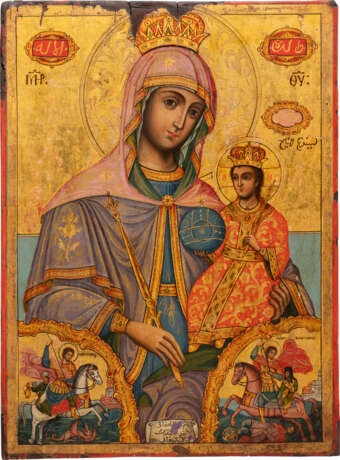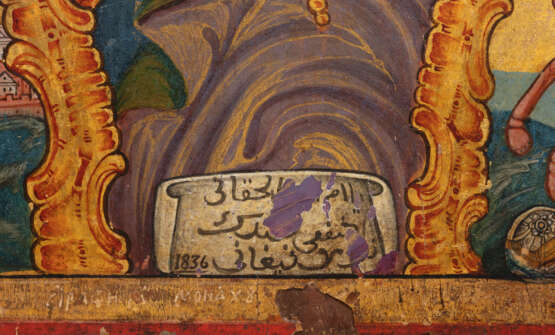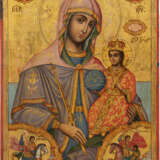A VERY FINE SIGNED AND DATED MELKITE ICON SHOWING THE MOTHER OF GOD AND CHRIST
04.11.2021 10:00UTC +01:00
Classic
Sold
10000EUR € 10 000
| Auctioneer | Hargesheimer Kunstauktionen Düsseldorf |
|---|---|
| Event location | Germany, Düsseldorf |
| Buyer Premium | 28.56% |
Archive
The auction is completed. No bids can be placed anymore.

ID 629767
Lot 404 | A VERY FINE SIGNED AND DATED MELKITE ICON SHOWING THE MOTHER OF GOD AND CHRIST
Estimate value
€ 6 000
SEHR FEINE DATIERTE MELKITISCHE IKONE MIT DER GOTTESMUTTER UND DEN HEILIGEN GEORG UND DEMETRIUS Mittlerer Osten, Michael Polychronis, datiert 1836 Schwere Laubhholz-Tafel. Eitempera auf Kreidegrund, Goldgrund, Nimben ornamental punziert. 41,7 x 31,2 cm. Arabisch bezeichnet und '1836' datiert am unteren Rand, griechische Inschrift am unteren Rand. Die Mutter Gottes trägt ein blaues Kleid in Türkis und ein Maphorion in Lila, mit grünem Futter, mit einer rosafarbenem Haube, die von einer goldenen Fibel geschlossen wird. Das Kind trägt einen zinnoberroten Chiton (kurzärmeliges Kleid) mit Zierbändern in der Art eines Diakonensticharions (Albe mit gekreuzter Stola). Die Kleider der Mutter und des Kindes sind mit Goldbändern verziert und mit floralen Motiven verziert. Auf dem unteren Band der Ikone sind in ornamentalen Kartuschen im Barockstil rechts der heilige Georg auf seinem weißen Pferd und links der heilige Demetrius auf seinem kastanienbraunen Pferd dargestellt. Die Inschriften der Ikone sind auf Arabisch und Griechisch: Mutter Gottes und Jesus Christus, in Arabisch unter den Akronymen auf dem goldenen Hintergrund. Auf dem unteren Rand steht in archaischem Arabisch und einer besonderen Kalligraphie: 'Oh Mutter des wahrhaftigen Gottes, lege Fürsprache ein für deinen Sklaven Abd Allah Fighani 1836'. Griechische Inschrift ebenfalls am unteren Rand. Kleinere Substanzverluste im Randbereich, punktuelle Einstimmungen. Michel Polychronis, auch bekannt als Michael der Kreter und Mikhail Polykhronis Kardali auf Arabisch, ist ein talentierter Ikonograph, der Ende des 18. Jahrhunderts auf Kreta geboren wurde. Als Sohn des Malers Polychronis de Candia, der seinerseits ein Schüler eines anderen berühmten Malers, Georgios Castrophylacas, war, tritt Michel le Crétois in die Fußstapfen seines Vaters, der im Nahen Osten tätig war. Ikonen von Polychronis von Candia befinden sich im Katharinenkloster auf dem Sinai, in der Kapelle des Heiligen Gefängnisses in Jerusalem und im orthodoxen Kloster des Heiligen Georg von el-Hmeira in Syrien. Der Sohn Michel wird sich in Syrien und im Libanon aufhalten und in dieser Zeit eine rege Tätigkeit entfalten. Später wird er auch nach Zypern berufen werden. Michel le Crétois ist dafür bekannt, dass er die postbyzantinische Kunst mit seiner melkitischen nahöstlichen Ikonographie aus dem 19. Jahrhundert erfolgreich miteinander verbindet. Diese zeichnet sich durch eine geschickte Mischung der byzantinischen Traditionen und westlichen, von der italienischen Barockkunst inspirierten Elementen aus und folgt damit dem damals modischen Stil des 'orientalischen Rokoko' mit natürlichen Mustern und komplexen künstlerischen Designs. Unser Ikonograph ist nicht nur für seine bewundernswerten Werke berühmt, sondern auch für den Einfluss, den er auf die lokalen Maler des 19. Jahrhunderts hatte, darunter die Familie al-Qara, Ne'meh Nasser al-Homsi und Mikhail Mhanna al-Qodsi. Michel Polychronis, der Kreter, war ein produktiver Künstler, wenn man die große Anzahl von Werken bedenkt, die er während seiner kurzen Zeit im Nahen Osten schuf. Expertise: Dar Antakya (2021).
| Auction house category: | Russian and Greek icons |
|---|
| Auction house category: | Russian and Greek icons |
|---|
| Address of auction |
Hargesheimer Kunstauktionen Düsseldorf Friedrich-Ebert-Strasse 11+12 40210 Düsseldorf Germany | ||||||||||||||
|---|---|---|---|---|---|---|---|---|---|---|---|---|---|---|---|
| Preview |
| ||||||||||||||
| Phone | +49 (0) 2113020010 | ||||||||||||||
| Fax | +49 (0) 21130200119 | ||||||||||||||
| Buyer Premium | 28.56% | ||||||||||||||
| Conditions of purchase | Conditions of purchase | ||||||||||||||
| Shipping |
Postal service pickup by yourself | ||||||||||||||
| Payment methods |
Wire Transfer | ||||||||||||||
| Business hours | Business hours
|





